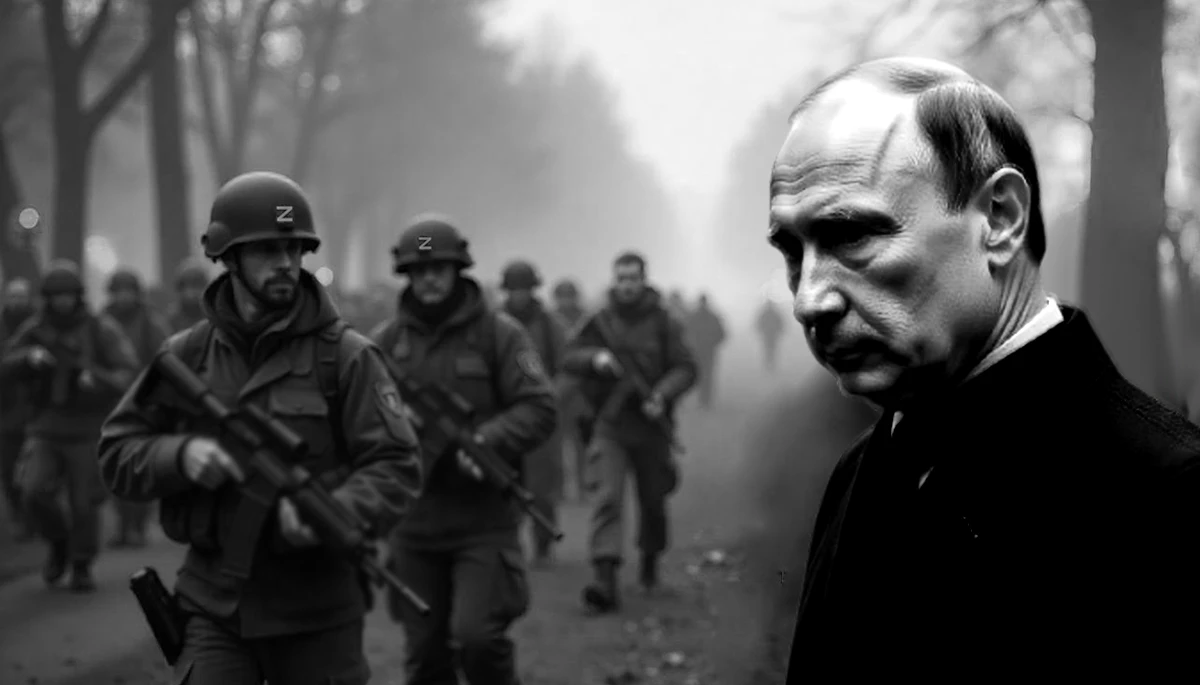Українською читайте тут.
Russia has occupied parts of Ukraine for over ten years. The Center for Information Resilience (CIR) and the Detector Media Research Center explore the tactics used by the occupying authorities to mobilise and recruit.
It has been widely reported that Russia has suffered significant casualties since its full-scale invasion of Ukraine in February 2022. While official figures are restricted by states on either side, American officials said in October 2024 that the number of dead and wounded stood at around 600,000.
Russia has sought to replenish its ranks through a range of mobilisation efforts and incentives, ranging from cash bonuses for those who enlist to the recruitment of prisoners.
In Ukraine’s occupied territories, some of which have been under Russian control since 2014, Moscow has relied on a combination of persuasion and manipulation to leave Ukrainians with little choice other than to fight for Russia.
In these regions, the local occupation authorities serve as the main enforcers of Russian orders to mobilise the population into the occupying army – and, according to the Ukrainian Military Administration authorities in Luhansk Oblast, they appear to have been allocated recruitment quotas that they are working aggressively to fulfil.
CIR and Detector Media have been analysing Russian military mobilisation in Ukraine’s Temporarily Occupied Territories (TOTs). Techniques include passportisation and youth initiatives, as well as more subtle information campaigns that avoid explicit references to mobilisation. Extensive data analysis, open source investigative techniques, and case study and content analysis were used to ensure a thorough and detailed examination of mobilisation strategies and tactics in the occupied territories, both before and after the full-scale invasion in 2022.
Context: Passportisation and humanitarian law
Any state that recruits residents of territories that it occupies into its own armed forces is in violation of international humanitarian law, according to the Rome Statute (Article 8(2)(b)(xv)) of the International Criminal Court (ICC). Geneva Conventions, in particular Article 51 of the IV Convention, prohibit both the coercion of civilians into occupying armed forces and “propaganda which aims at securing voluntary enlistment”.
According to the Institute of Strategic Research and Security, Russia had been implementing programmes to recruit combat reserves in the occupied Luhansk and Donetsk regions from the beginning of the occupation of the first Ukrainian territories in 2014, using them as preparatory training for full-scale wartime mobilisation. Pavlo Lysyanskyi, the Institute’s director, estimated that Russians had forcibly mobilised more than 100,000 men from the occupied territories by 2022, with many deployed for frontline combat.
This preparation included creating reserves, primarily through passportisation, a process involving the mass naturalisation of citizens in contested territories. This meant that residents in these territories acquired the duties of Russian citizens, and had to enlist in the military. Russia had used passportisation policies in territories in Georgia and Moldova in 2002.
In March 2024, an AP investigation found that Russian passports had been successfully imposed on the majority of occupied Ukraine’s population. According to Russian law, those without a Russian passport are subject to imprisonment as a “foreign citizen”. A Russian passport is also required to prove property ownership and access basic services such as health care and retirement income.
According to the Ukrainian Security and Cooperation Centre (USCC), mobilisation is “an opportunity for the aggressor to psychologically break people under occupation, to impose its own propaganda, and to take control (in fact, hostage) of an active part of society, and this applies not only to the mobilised people themselves but also to their family members.” The overriding intent appears to be repression, subjugation, and the enforcement of some kind of Russian identity on local residents.
‘Disproportionate targeting’ of Crimean Tatars
Since 2015, human rights activists have raised concerns about the increased likelihood of mobilisation among Crimean Tatars and other ethnic groups in Crimea.
While there are no official statistics on mobilised communities, the largely Muslim Crimean Tatars – who are thought to make up around 13% of Crimea’s population – appear to have been disproportionately targeted. Ukrainian rights organisation CrimeaSOS estimates that 90% of all mobilisation notices have been given to Crimean Tatars since the main mobilisation drive started in September 2022. Ukraine’s president Volodymyr Zelenskiy described this as “a conscious effort to destroy the Crimean Tatar nation”.
Cases involving the deliberate persecution of Crimean Tatars have also been documented, including the issuing of summonses by military registration and enlistment offices to individuals visiting mosques.
Occupation authorities have also used information campaigns urging Crimean Tatars to join the Russian army. One of the largest campaigns focused on portraying Russia as a multiethnic state where various groups demonstrate their patriotism and loyalty to the country (Figure 1).
This campaign also exploited sensitive issues such as land ownership by promising land in other regions to those who joined the army. For instance, Figure 2 refers to acquiring land through the “Dalnevostochny Gectar” – or “Far-Eastern Hectare” – scheme. Far-Eastern Hectare is a government program established to encourage settlement and economic development in the Far Eastern Federal District. Under this law, Russian citizens can receive up to one hectare of land in the region free of charge for personal use, business, or agricultural purposes.
Figure 1: Screenshot from a Telegram channel, which states: “There are many nationalities, but there is only one Russia! It’s time to defend the Motherland!”
Figure 2: Screenshot from a Telegram channel, stating: “And after the war I will stay here, in Odesa. My ancestors came from these lands. I'll be back home in some sense. – Will you buy land here? – No, I will get it as ‘Dalnevostochny Gectar’ [Far-Eastern Hectare]. And the participants in the SMO [‘Special Military Operation’] get it prior to the other categories.”
According to the Mission of the President of Ukraine in the Autonomous Republic of Crimea, one example of “covert mobilisation” is the so-called voluntary deployment of Crimean doctors to occupied areas of Donetsk and Luhansk Oblasts near the front lines. Despite a lack of enthusiasm among local medical professionals, occupation authorities staged public statements and televised reports showcasing "volunteer doctors", who were ultimately assigned to military rather than civilian medical roles.
In some cases, final-year university students have reportedly been summoned for military duty. In July 2023, CrimeaSOS reported an incident where teachers at Simferopol University, Crimea, informed a student that he could only take his exams if he signed the summons. According to CrimeaSOS, such incidents are not uncommon, but these conversations are held in private to prevent them from becoming public. In January 2023, the National Resistance Centre reported that in preparation for a new wave of mobilisation, the Russians issued a directive to expel all students in their third to fifth years who are subject to mobilisation and have student debt.
Additional conscription offices in smaller settlements outside of the district centres, including outdoor locations and mobile conscription brigades, have also been established, according to Russian state media. These mobile offices are often set up in public places, such as near shopping malls, to target individuals who might otherwise avoid visiting conscription centres.
FSB supervision in ‘DNR’ and ‘LHR’
According to Serhii Haidai, former head of the Ukrainian Military Administration in Luhansk Oblast, there have been multiple recruitment “waves” in occupied Luhansk Oblast since the beginning of the full-scale invasion. The initial wave, as stated by Haidai, was relatively straightforward as it was conducted by “Luhansk People's Republic” (or “LNR”) authorities. During that time, the occupying authorities recruited anyone they could find, but individuals could pay to be released, allowing many to either leave or hide in their cities.
Since the spring of 2022, reports suggest that Russian commanders are dissatisfied with recruitment in the “DNR” and “LNR”, however. Eyewitnesses reported that certain recruitment “quotas” were not met, allegedly because local commissariats “pity the locals and don't take as many as they could, so they don't fit the quota”.
Later waves of mobilisation in occupied territories were reportedly supervised by representatives of Russian special services, in particular, the Federal Security Service (FSB). According to Haidai, the special services had a “clear task” to recruit the maximum number of men. The FSB’s direct intervention meant that avoiding conscription by paying off officials, among other schemes, was no longer possible.
Mobilisation has had a significant impact on the number of workers available in critical utilities and communal services in the occupied territories. For example, Mariupol-based website 0629 reported that several neighbourhoods in the central district of Mariupol were left without heating following a large-scale accident in early 2024. The apartments had no heating for almost a month, and utility workers came from as far away as St. Petersburg to repair the damage.
The hunt for deserters
From February 2022 to the present day, most of the local “mobilised” have the status of “volunteers without a contract” or “without status”. They are ostensibly not military personnel under current Russian law and should not be held legally responsible for leaving their place of service under Russian laws.
However, many of them are either physically unable or afraid to leave the combat zone, given the “DNR”’s and “LNR”’s typical unlawful methods of influence, beatings, abductions, and torture against those who have “left their place of service”, documented in various Telegram channels.
Since the autumn of 2022, Russians have conducted a “hunt” for deserters, and they have placed posters in many “DNR” cities, including Illovaisk, Yenakiieve, and Donetsk, naming mobilised people who have deserted (Figure 3). When the person is found, reports suggest that no investigative actions are taken – instead the person returns to the military unit, where he is forced to participate in hostilities and could face abuse.
Figure 3. Example of a wanted poster placed in the streets of Yenakiieve, Donetsk oblast, from a Telegram channel.
Youth and children targeted
Analysts and researchers have detailed how Russia has targeted young people, students, and even children from the occupied territories in an attempt to lay a foundation for future mobilisation into its army. After the occupation of Crimea in 2014, Russian authorities started to employ various tactics – including informational campaigns and motivational talks at educational institutions – to convince Crimean youth to join the Russian army.
These include the “Conscript Day” event targeted at conscripts and students in the 10th and 11th grades; a Russian state initiative called “Yunarmia” (or Young Army) aimed at militarising young people by portraying Ukraine as an enemy of Russia; as well as military training courses in educational institutions and campaigns that promote military service as honourable and patriotic.
These actions are an attempt to target young people during their developmental stages and inculcate in them a sense of Russian identity. Human rights experts argue that the militarisation of children and young people, and initiatives like “Yunarmia”, in the occupied territories constitute a war crime, as involving children in military operations violates international humanitarian law.
The Kremlin's strategy of erasing the Ukrainian identity of children in the TOTs and conditioning them to serve in its military gains momentum with each year of occupation. Russia has occupied parts of Ukraine for over 10 years now, making it highly likely that some Ukrainian men who were children in 2014 are now fighting against Ukraine. Across the globe, children are seen as the hope for the future, but in Russian-occupied territories of Ukraine, some are being turned into tools for war.



